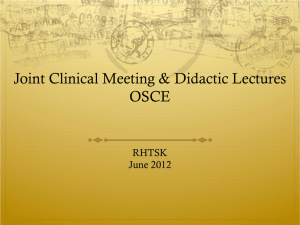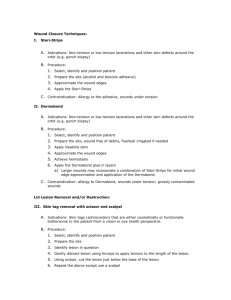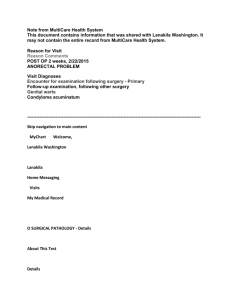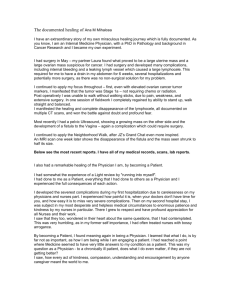Brain-MRI-Reports
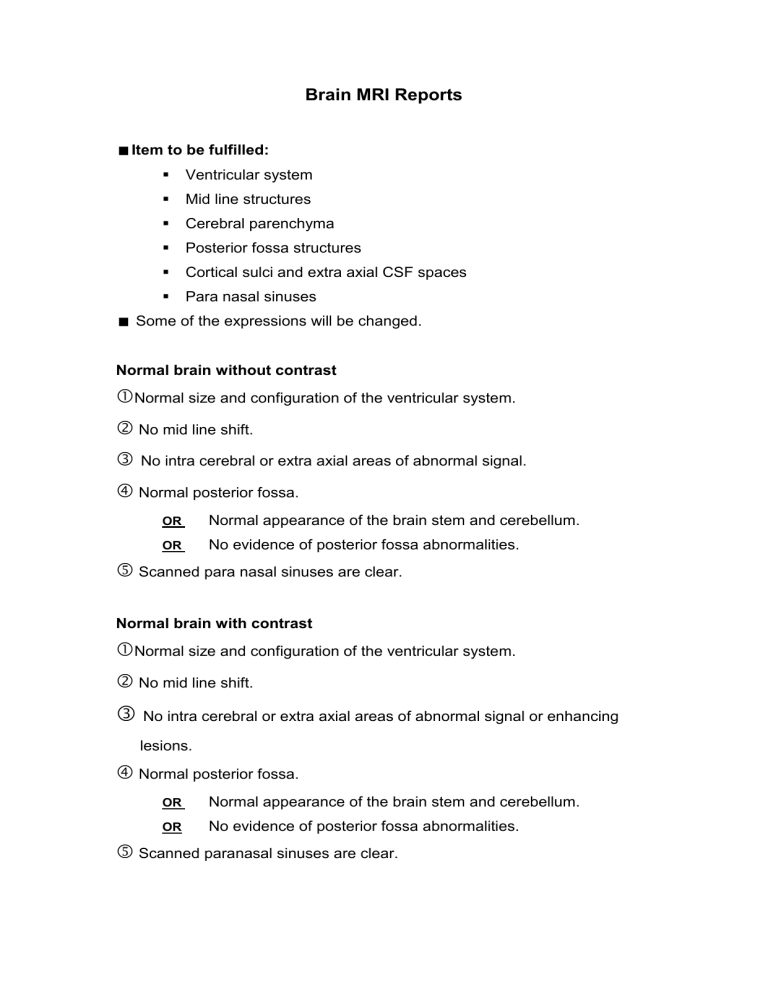
Item to be fulfilled:
Ventricular system
Brain MRI Reports
Mid line structures
Cerebral parenchyma
Posterior fossa structures
Cortical sulci and extra axial CSF spaces
Para nasal sinuses
Some of the expressions will be changed.
Normal brain without contrast
Normal size and configuration of the ventricular system.
No mid line shift.
No intra cerebral or extra axial areas of abnormal signal.
Normal posterior fossa.
OR Normal appearance of the brain stem and cerebellum.
OR No evidence of posterior fossa abnormalities.
Scanned para nasal sinuses are clear.
Normal brain with contrast
Normal size and configuration of the ventricular system.
No mid line shift.
No intra cerebral or extra axial areas of abnormal signal or enhancing lesions.
Normal posterior fossa.
OR Normal appearance of the brain stem and cerebellum.
OR No evidence of posterior fossa abnormalities.
Scanned paranasal sinuses are clear.
Normal Brain [Trauma]
Normal size and configuration of the ventricular system.
No mid line shift.
No intra cerebral or extra axial hemorrhage or blood degeneration
products.
Normal posterior fossa.
OR Normal appearance of the brain stem and cerebellum.
OR No evidence of posterior fossa abnormalities.
Scanned paranasal sinuses are clear.
No fracture lines seen.
NB If fractures are present mention the site (frontal, parietal, …) and type
(fissure, depressed, comminuted,….). when subgalial hematoma is present it should be mentioned.
Normal Brain (Sinusitis)
Normal size and configuration of the ventricular system.
No mid line shift.
No intra cerebral or extra axial areas of abnormal signals.
Normal posterior fossa.
OR Normal appearance of the brain stem and cerebellum.
OR No evidence of posterior fossa abnormalities.
Partial or total obliteration of ........ sinuses by mucosal thickening showing
low signal in T1 and high signal in T2WI denoting sinusitis [mention the
affected sinuses, maxillary, ethmoidal...,].
Normal brain old age
Symmetrical dilatation of the ventricular system with prominence of the
extraaxial CSF space.
No mid line shift.
No intra cerebral or extra axial areas of abnormal signal.
Normal posterior fossa.
OR Normal appearance of the brain stem and cerebellum.
OR No evidence of posterior fossa abnormalities.
Scanned para nasal sinuses are clear.
Abnormal Brain
To describe a lesion you should mention the following points:
Definition [well defined, ill- defined]
Shape [ oval, rounded, irregular…]
Size [-----x------x------ cm in maximal AP, transverse and cranio caudal diameters respectively]
Site [intra axial, extra axial, frontal,parietal, …..]
Surrounding edema [If present]
Mass effect which includes o effacement of the cortical sulci o Compression of the ventricle o Midline shift
Signal intensity in T1, T2 and FLAIR images
possibilities include:
Low T1 high T2 [many lesions]
High T1 high T2 [subacute blood]
Low T1 low T2 [vessels, calcium, ...]
High T1 intermediate T2 [fat,...]
Intermediate T1 and T2 [some lesions]
Intra cerebral hemorrhage
A well defined, oval shaped area of blood signal is seen in the …..
[Mention the site of the lesion]
. It showed ……….
If blood is recent [intermediate signal in T1WIs with very dark signal in T2WIs].
Early sub acute blood [high signal in T1WIs and dark signal on
T2WIs] [intracellular met HB].
Late sub acute blood [high signal in all pulse sequences]
[Extracellular met HB].
Chronic blood [very dark signal in all pulse sequences]
[hemosidren].
NB In cases of hematoma with mixed signal either you say
The hematoma showed mixed signal intensities , its major part showed ….. in T1WIs and ……. In T2WIs, while the smaller part showed …. In T1WIs and …… in T2WIs.
OR
The hematoma showed mixed signal intensities, it's central part showed …… in T1WIs and ….. in T2WIs while it's peripheral part showed …… in T1WIs and …. In T2WIs.
NB In case you see a black line surrounding the hematoma you say a rim of persistent low signal in all pulse sequences is seen surrounding the hematoma denoting hemosidren formation.
NB A narrow zone of peripheral brain edema my be identified around the hematoma showing low signal in T1WIs and high signal in T2WIs.
The lesion measures ----x ----x --- cm maximal AP, transverse and
craniocaudal diameters respectively.
The lesion exerts a mass effect in the form of effacement of the cortical
sulci
compression of the ipsilateral ventricle
contra lateral shift of the
midline structures.
Normal posterior fossa (if the lesion is not in the posterior fossa).
Scanned paranasal sinuses are clear.
Extra axial hemorrhage
A well defined extra axial (elliptical or cresentic shaped) hematoma is seen in the …… (Mention the site of the lesion).
It showed ……….. Mention the signal changes in T1 and T2WIs as described with the intra cerebral hematoma however,
The subdural hematoma may show sedimentation level, then you mention the signal changes of its upper and lower components.
No edema is present in cases of epidurall or subdural hematoma.
No hemosidren seen in there cases [usually].
Sub arachnoid hemorrhage is not assessed by MRI, if so, you can follow the same items used for CT and remember to change the densities to signal intensities.
Fresh blood signal is seen smearing the cortical sulci and extra axial CSF
spaces
extension into the ventricular system showing dark signal in T2 WIs
NB You cannot see acute subarachnoid blood in T1 WIs
Also mention that the ventricular system is dilated denoting the presence of communicating hydrocephalus which is usually seen in cases of subarachnoid
hemorrhage.
Normal posterior fossa (if the lesion is not in the posterior fossa).
Scanned paranasal sinuses are clear.
Brain infarction
A w ell defined area of abnormal signal intensity is seen in …. [mention the site of the lesion]. It showed low signal in T1WIs and high signal in T2 and
FLAIR images.
Not included [we do not usually measure the size of the infarct]
No intra cerebral or extra axial hematoma or blood degradation produce .
OR foci of blood signal are seen within the lesion in cases of hemorrhagic infarction. The blood signal you will see is either
Acute blood [intermediate signal in T1 and dark signal in T2]
[Deoxy HB] OR
Sub acute blood [high signal in both T1 and T2WIs] [extra cellular met HB].
Normal posterior fossa [if the lesion is not in the posterior fossa].
Scanned paranasal sinuses are clear.
Lacunar infarction
A small well defined lesion of abnormal signal intensity is seen …..
[Mention the site of the lesion]. It showed low signal in T1WIs and high
signal in T2 and FLAIR WIs and exerts no mass effect on the adjacent
structures.
NB Old lacunar infarct will show low signal in T1 and FLAIR images with high signal in T2WIs [CSF signal].
NB The same rule is applied for cases with multiple infarcts.
Normal size and configuration of the ventricular system with no midline
shift.
OR Symmetrical dilation of the cerebral ventricles with prominence of extra axial CSF spaces [in old patients with brain atrophic changes]
No intra cerebral or extra axial hemorrhage or blood degradation products.
Normal posterior fossa [if the lesion is not in the posterior fossa].
Scanned paranasal sinuses are clear.
Sub cortical arteriosclerotic encephalopathy
Exaggerated periventricular white matter signal intensity in all pulse
sequences denoting sub cortical ischemic changes.
NB Lacunar infarcts may be seen in cases with subcortical arteriosclerotic encephalopathy, then you describe these infarcts as mentioned before.
Normal size and configuration of the ventricular system with no midline
shift.
OR Symmetrical dilation of the cerebral ventricles with prominence of extra axial CSF spaces [in old patients with brain atrophic changes]
No intra cerebral or extra axial hemorrhage or blood degradation products.
Normal posterior fossa [if the lesion is not in the posterior fossa].
Scanned paranasal sinuses are clear
Space occupying lesion [tumor, abscess,…]
Points to be evaluated:
Definition (well defined, ill-defined)
Shape (rounded, oval, irregular, …)
Size----x ----x ----cm in maximal AP, transverse and cranio caudal diameters respectively
Site (frontal, temproparietal , …, brain stem, cerebellum,..)(Left or right).
Enhancement (no, homogenous, heterogen ous, marginal, …)
Surrounding edema (if present)(grade I,II,III) Low signal in T1 and high signal in T2 WIs
Grade I = area less than 2 cm around the lesion
Grade II = area more than 2 cm but less than 1/2 the cerebral hemisphere in which the lesion is present.
Grade III = area more than 1/2 the cerebral hemisphere in which the lesion is present
Mass effect which includes:
Effacement of the cortical sulci
Compression of the ventricle
Midline shift.
Meningioma
A well defined oval shaped SOL is seen in the …. [Mention the site of the
Lesion]. It showed low signal in T1WIs and high signal in T2WIs.
NB Some meningioma shows intermediate signal in both T1 and T2WIs
NB Some meningiomas may contain low signal foci within the tumor mass representing calcification or signal void blood vessels.
The lesion measures …x…..x….. cm in maximal AP, transverse and crainio caudal diameters respectively and showed homogenous pattern of contrast enhancement.
NB An enhancing dural tail may be identified and should be mentioned. A localized area of calverial bone thickening may be seen at the base of the meningioma, this area will show persistent low signal in all pulse sequences [bone sclerosis similar to cortical bone].
The lesion is surrounded by grade --- perifocal brain edema showing low
signal in T1 and high signal in T2 WIs.
The lesion and edema exert a mass effect in the form of -------, --------, -----
Normal posterior fossa (if the lesion is not in the posterior fossa).
Scanned Para nasal sinuses are clear
OR Scanned Para nasal sinuses showed mucosal thickening in the
----,----- (mention the name of the affected sinuses ) denoting sinusitis.
Space occupying lesion
Astrocytoma / Glioma
A well defined [or an ill
– defined], ------[mention the shape of the lesion oval, irregular,…] shaped SOL is seen in the -----[mention the site of the
lesion]
If the lesion is not enhanced then write [Showing no evidence
of post contrast enhancement]
OR Showing heterogenous (or marginal) enhancement with central areas of necrosis and breakdown.
OR The lesion is mainly cystic with an enhancing mural nodule measuring….cm in maximal transverse diameters [mention the measurement of the cyst and nodule]
The lesion is surrounded by grade------- perifocal brain edema showing low signal in T1 and high signal in T2 WIs. The lesion and edema exert a mass effect in the form of -------, ----------, ----------
Normal posterior fossa (if the lesion is not in the posterior fossa).
Scanned Para nasal sinuses are clear
OR Scanned Para nasal sinuses showed mucosal thickening in the
----,------ (mention the name of the affected sinuses ) denoting sinusitis.
Space occupying lesion
Metastatic deposits
Multiple well defined SOLs are seen in -----[mention the site of the
lesions] [cerebral hemisphere, both hemisphere, cerebellum, brain stem,
infratentonial, supratentorial , both……].
The lesions range in size between -------[the smallest lesion] and -------[the
largest lesion] and showed -------- [mention the pattern of enhancement.
The largest lesion measures ----- x ----- cm in maximal diameters and is
located in ---- [mention the site of the largest lesion].
The lesions are surrounded by variable degrees of perifocal brain edema showing low signal in T1 and high signal in T2 WIs. The lesions and edema exert a mass effect in the form of -------, -------, ------
Normal posterior fossa [if no lesions in the posterior fossa].
Scanned Para nasal sinuses are clear
OR Scanned Para nasal sinuses showed mucosal thickening in the
--,------ (mention the name of the affected sinuses ) denoting sinusitis.
NB A solitary metastatic deposit (a patient known to have primary malignancy is described in the same way as glioma).
Cyst
A well defined cystic SOL is seen in the ------
Ex.
Arachnoid cyst is usually present in the inferior temporal region against the greater wing of the sphenoid bone.
Ex.
Epidermoid cyst is usually located in the cerebellopontine angle.
Ex.
Dermoid cyst is usually located in the midline and contains fat.
The lesion measures -----X----- cm in maximal diameters and showed low signal in T1 and high signal in T2 WIs with no post contrast enhancement
[if the patient was injected with IV contrast]
NB Matrix calcifications are not usually seen in MR images
If present they may show low or high signal in T1 [depending on the mobility of the hydrogen protons], however they will show low signal in
T2 WIs
NB Dermoid cysts usually contain fat, then you have to say that the lesion contains fat signal which appeared high in T1 and intermediate in T2
WIs.
NB Colloid cysts are usually diagnosed by their location in the midline plane in the region of the anterior part of the 3 rd ventricle.
Colloid cyst can show any signal in T1 [hypo or hyperintense] and any signal in T2 [hypo or hyperintense] with no contrast enhancement.
Sometimes marginal enhancement is seen in the cyst which shows low signal in T1 WIs.
Most of the cysts are not surrounded by edema, but they
exert a mass effect, then you have to mention the manifestation of the mass effect in the form of ------, -----, ------.
NB Colloid cyst may be associated with hydrocephalus due to compression of the foramina of monro.
NB In cases of dermoid cysts please look for fat globules in the subarachnoid spaces (sulci, fissures, cisterns) as well as in the ventricles. If they are present this means that the cyst has ruptured into the subarachnoid space. Fat globules will appear bright in T1 WIs
NB Hydatid cyst is described following the steps mentioned for glioma.
NB In cases of porencephalic cyst you should mention it's communication with the ventricular system.
Normal posterior fossa [if no lesions in the posterior fossa].
Scanned Para nasal sinuses are clear
OR Scanned Para nasal sinuses showed mucosal thickening in the
--,------ (mention the name of the affected sinuses ) denoting sinusitis.
Acostic neuroma
A well defined SOL is seen in the ------- [left or right] cerebello- pontine
angle region extending inside the adjacent internal auditory canal which is
widened [or not]
The lesion measures ---- x ---- in maximal transverse diameters and shows low or intermediate signal in T1 WIs and high signal in T2 WIs with homogenous or heterogenous pattern of contrast enhancement.
The lesion is associated [or not] with widening ± pressure erosion of the
ipsilateral internal auditory canal.
Crainiopharyngioma
A well defined partly cystic and partly solid SOL is seen in the supra sellar
area with it's main bulk exactly in the midline plane [or slightly to the left or
right of the midline]
The lesion measures ---- x ---- in maximal transverse diameters
The cystic component showed low signal in T1 and high signal in T2 WIs while the solid component showed intermediate signal in both T1 and T2
WIs with homogenous or heterogenous pattern of contrast enhancement.
NB The cystic component may show high signal in T1 and T2 WIs due to its high protein content [this finding can help in the diagnosis of carniopharyngioma]
NB Note that the enhancement in craniopharyngioma is variable, the cystic component usually shows marginal or no enhancement while the solid component usually shows homogenous or heterogenous
Enhancement. The foci of calcification may not be seen on MR images.
Usually there is no edema, but mass effect is may be present in the form of compression of the 3 rd ventricle with consequent obstructive hydrocephalic changes of both lateral ventricles.
NB The lesion may extend inside the sella
[ best seen in coronal images
] or may extend into the para sellar area or even into the posterior fossa via the pre pontine cistern (rare)… These extensions should be mentioned
Normal posterior fossa. If the lesion has extended into the
posterior fossa
then you can say : No evidence of cerebellar or brain stem parenchymal
lesions
Scanned Para nasal sinuses are clear
OR Scanned Para nasal sinuses showed mucosal thickening in the
--,------ (mention the name of the affected sinuses ) denoting sinusitis.
Space occupying lesion
Suprasellar meningioma, dermoid, ….. are described following the steps mentioned for craniopharengioma with careful attention to the difference in the enhancement pattern and the degree of mass effect as well as the variable extensions.
Intrasellar pituitary adenoma
A well defined intrasellar SOL is seen extending (or not) into the supra
sellar cistern.
The lesion measures ----x ----x ---- cm in maximal diameters and shows
intermediate signal in T1 and T2 WIs with homogenous or heterogenous
pattern of enhancement
[ mention the type of enhancement
].
NB The extensions of the lesion should be mentioned in details specially the supra sellar extension with obliteration of the suprasellar cistern
[ if present best seen in the coronal images
]
, compression of the hypothalamus
[ also seen in the coronal images better than CT scan
]
Extension into the suprasellar area may also compress and streach the optic chiasm. These findings should be mentioned in the report.
Parasellar extension into the cavernous sinuses and affection of the internal carotid arteries should be mentioned
NB Extension into the cavernous sinus is diagnosed by the presence of tumor tissue lateral to the internal carotid artery.
NB Also mention that the internal carotid artery is patent showing normal signal void
[ usual finding
]
.
NB Infrasellar extension with erosion of the sellar floor and invasion of the sphenoid sinus indicate that the adenoma is invasive then you mention in the conclusion of the report that the adenoma is invasive and do not say malignant .
Usually there is no edema, but mass effect may be present in the form of
compression of the 3 rd ventricle with consequent obstructive hydrocephalic
changes of both lateral ventricles.
If there is no retrosellar extension, you mention that the posterior fossa
structures are normal
Scanned Para nasal sinuses are clear
OR Scanned Paranasal sinuses showed mucosal thickening in the -
-,------ (mention the name of the affected sinuses ) denoting sinusitis.
NB In cases of microadenoma you can say
A well defined small focal lesion is seen within the ----- (left or right) aspect
of the pituitary gland.
The lesion usually shows less enhancement compared o the normal
pituitary tissue and may be associated with the following:
Focal contour bulge of the superior or inferior surface of the pituitary gland
( best seen in coronal images
)
.
Deviation of the infundibular stalk to the opposite
( or may be to the same side
)( also seen in coronal images
)
.
The lesion is totally enclosed within the sella with no extrasellar
extensions, no edema, and no mass effect.
Mention that the cerebral parenchyma and ventricles appear normal with
no midline shift, also mention that the posterior fossa
structures are normal
Scanned Para nasal sinuses are clear
OR Scanned Para nasal sinuses showed mucosal thickening in the
--,------ (mention the name of the affected sinuses ) denoting sinusitis.
Intracranial calcification
Most of the intracranial calcifications are not usually seen on MR images
CT is the examination of choice in these cases
In cases of gyral calcification, MR is usually helpful in detection of associated vascular malformation as well as the enlargement of the ipsilateral choroids plexus.
Aneurysm
A well defined rounded ------x----- cm [mention the measurements of the
lesion] lesion is seen in the ------- [mention the site] common sites include:
Suprasellar region to the left or right of the midline plane
Within the sylvian fissure.
In the prepontain cistern [basilar tip aneurysm]
The lesion showed signal void in all pulse sequences denoting patent
lumen.
NB If the lesion is more than 2cm in diameter
[ gaint aneurysm
]
it may show internal thrombosis then you can say that the lesion showed variable signal intensities in all pulse sequences with characteristic layring due to turbulence of flow clearly seen in T2 WIs.
The patient lumen show signal void in all pulse sequences while the thrombosed lumen showed mixture of low and high signals representing the stages of intraluminal clot [deoxy- Hb, met- Hb,..]
Normal size and configuration of the ventricular system with no midline
shift.
Normal posterior fossa (if no lesions are present in the posterior fossa ).
Scanned Para nasal sinuses are clear
OR Scanned Para nasal sinuses showed mucosal thickening in the
--,------ (mention the name of the affected sinuses ) denoting sinusitis.
Aneurysm rupture
A well defined rounded ------x----- cm [mention the measurement of the
lesion] lesion is seen in the ------- [mention the site] common sites include:
Suprasellar region to the left or right of the midline plane
Within the sylvian fissure.
In the prepontain cistern [basilar tip aneurysm]
The lesion is surrounded by an irregular shaped area of recent blood
signal [intermediate signal in T1 and dark signal in T2
WIs] measuring -------X ------- cm in diameters
NB We do not usually inject contrast in these cases
The ventricles are usually dilated and may contain fresh blood signal then
you can say: mild or moderate symmetrical dilatation of the supra and
infratentorial cerebral ventricles
periventricular edema due to retrograde
transependymal CSF permeation
intraventricular recent blood signal
seen in the ------------ (mention the affected ventricles).
If blood is present in the 4th ventricle then you can say : normal
appearance of the brain stem and cerebellum, but do not write the usual
statement.
Scanned Para nasal sinuses are clear
OR Scanned Para nasal sinuses showed mucosal thickening in the
--,------ (mention the name of the affected sinuses ) denoting sinusitis.
Arteriovenous malformation
A well defined area of abnormal vascularity is seen ----- [mention the site of the lesion] showing serpigenous signal void vascular channels.
Perifocal brain edema may present and a mild mass effect may be also
seen then you should mention these findings.
NB Ischemic areas in the region of the AVM will appear of low signal in T1 and high signal in T2 WIs due to direct shunting of blood from the arterial to the venous side.
Normal size and configuration of the ventricular system with no midline
shift.
Normal posterior fossa (if no lesions are present in the posterior fossa ).
Scanned Para nasal sinuses are clear
OR Scanned Para nasal sinuses showed mucosal thickening in the
--,------ (mention the name of the affected sinuses ) denoting sinusitis.
Cavernous hemangioma
A well defined intraaxial lesion of abnormal signal is seen---- [mention the site of the lesion]
The lesion showed high signal in all pulse sequences with a well defined
margin of marked hypointensity specially noted in T2 WIs.
The lesion measures -------X ----- cm in maximal diameters and showed no
appreciable post contrast enhancement.
NB Minimal perifocal brain edema may be present around the lesion, then mention it and say showing low signal in T1 and high signal in T2 WIs.
NB No mass effect exerted by the lesion, if present you can say that the lesion exerts minimal mass effect on the adjacent structures.
NB In case of multiple lesions, you start to described the largest one [as mentioned above], then you say multiple similar lesions are seen in ----
[mention the site of each lesion]
Normal size and configuration of the ventricular system with no midline
shift.
Normal posterior fossa (if no lesions are present in the posterior fossa ).
Scanned Para nasal sinuses are clear
OR Scanned Para nasal sinuses showed mucosal thickening in the
--,------ (mention the name of the affected sinuses ) denoting sinusitis.
Intra ventricular lesions
A well defined --------- shaped (mention the shape of the lesion) is seen -----
(mention the site of the lesion).
Possible sites include:
Centered on the region of the 4th ventricle midline posterior fossa.
Within the body or frontal horn of the lateral ventricle (left / right).
Centered at the anterior aspect of the 3rd ventricle.
The lesion showed intermediate signal in T1 WIs with high signal in T2 WIs
and homogenous/ heterogenous pattern of post contrast enhancement
with
foci of matrix calcifications. The surface of lesion appeared smooth
or lobulated.
The ipsilateral ventricle is dilated with
± per ventricular edema due to retrograde transependymal CSF permeation.
NB In cases of choired plexus papilloma , the whole ventricular system is dilated due to communicating hydrocephalus secondary to CSF over production by the lesion.
NB If the tumor has penetrated the wall of the ventricle it will initiate brain edema around, then maliganent transformation is suspected.
Normal posterior fossa (if no lesions are present in the posterior fossa ).
Scanned Para nasal sinuses are clear
OR Scanned Para nasal sinuses showed mucosal thickening in the
--,------ (mention the name of the affected sinuses ) denoting sinusitis.
